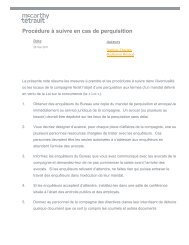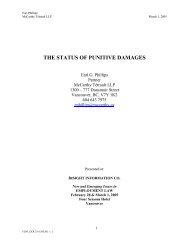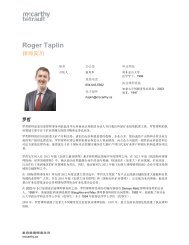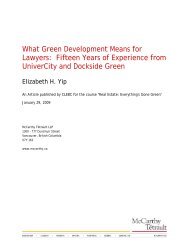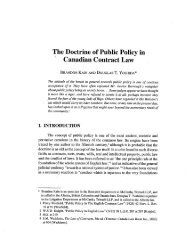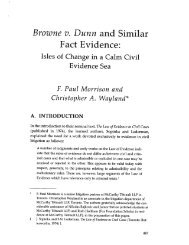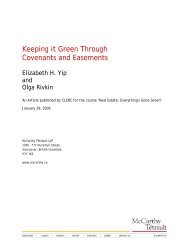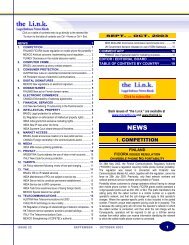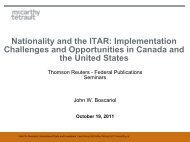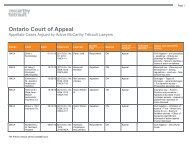Presentation Material - McCarthy Tétrault
Presentation Material - McCarthy Tétrault
Presentation Material - McCarthy Tétrault
You also want an ePaper? Increase the reach of your titles
YUMPU automatically turns print PDFs into web optimized ePapers that Google loves.
Chris Falk<br />
Stefanie Morand<br />
<strong>McCarthy</strong> Tétrault LLP<br />
• did not consider the use of related party transactions on substantially arm’s length terms<br />
or the use of Canco funds to repay the Brother Note to be relevant factors in his<br />
determination that the impugned transactions were not abusive; and<br />
• noted that the GAAR framework should achieve a fair result. 51<br />
The Crown has appealed the decision in respect of both subsection 84(2) and the GAAR.<br />
Relevance of the Decision<br />
As noted above, Mr. Justice Hershfield’s obiter comments in respect of pipeline planning should<br />
be pleasing to post-mortem planners. However, the real significance of Mr. Justice Hershfield’s<br />
decision is likely his conclusion that “subsection 84(2) must be read more literally in all cases<br />
and GAAR applied in cases of abuse”. 52 If this conclusion – which the authors think is correct –<br />
is confirmed by the Federal Court of Appeal, it should be a significant victory for post-mortem<br />
planners regardless of the Federal Court of Appeal’s decision on GAAR since the arguments<br />
against the application of the GAAR in the context of post-mortem planning are – in the view of<br />
the authors – significantly stronger than those in MacDonald. 53<br />
Practical Advice Regarding Pipelines in Light of CRA’s Position<br />
While the authors are of the view that, in the normal course, the CRA’s position that subsection<br />
84(2) may apply to deem the estate to have received a dividend in a typical pipeline transaction<br />
is not well-founded, they note as follows:<br />
• In many cases, where the deceased did not wholly-own the corporation (e.g., where a<br />
prior estate freeze had been undertaken), it may be possible to implement a pipeline<br />
without it being necessary to wind up, discontinue or reorganize any business carried on<br />
by the corporation.<br />
• To avoid the audit risk, where viable in implementing a pipeline, it is preferable to fall<br />
within the circumstances in which the CRA has ruled favourably. 54<br />
• Where this is not viable, it may be helpful to structure pipeline transactions such that<br />
they include a subsection 88(1) wind-up so that subsection 84(2) is expressly stated not<br />
to apply on the wind-up. 55<br />
51<br />
52<br />
53<br />
54<br />
See, for example, paragraph 139 of the decision where Mr. Justice Hershfield stated as follows:<br />
In closing, I add that in not applying GAAR to the share sale I am mindful of what was<br />
enunciated on more than one occasion in Canada Trustco; namely, the analysis of GAAR<br />
requires consideration of fairness. Indeed in the opening paragraph of Canada Trustco, the<br />
Supreme Court of Canada said the GAAR framework should achieve fair results. The<br />
allowance of this appeal ensures a fair result. A tax plan that ensures the reconciliation of<br />
genuine capital losses should not be the subject of a GAAR assessment, at least in these<br />
circumstances, unless the Act expressly denies it.<br />
Supra, note 5, at para. 80.<br />
See supra, note 36.<br />
E.g., keeping the corporation in existence as a separate entity for at least a year and having it continue its<br />
business, and only thereafter repaying the promissory note progressively over time.<br />
560600/422632<br />
MT DOCS 11864055v1G<br />
18



